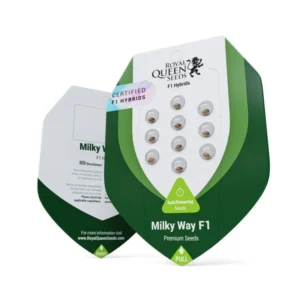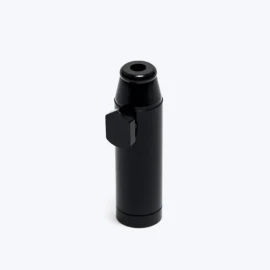Orion F1
12,00 €
Above-the-Fold Quick Reference
Orion F1 represents the next generation of autoflowering cannabis, delivering true F1 hybrid vigor with exceptional uniformity and reliability. This compact powerhouse combines the genetics of Blue Mammoth Auto, Blue Dream, and Amnesia to create an ideal strain for beginners and experienced growers seeking consistent, high-yield results in small spaces.
Quick Specifications
- Genetics: Blue Mammoth Auto × Blue Dream × Amnesia (true F1)
- Type: Autoflowering, F1 hybrid
- Cycle: 65–70 days seed→harvest
- Height: 64–80 cm (compact)
- Indoor yield: up to 500–600 g/m² (XXL-class)
- Potency: realistic 20–25% THC; very low CBD
- Terpenes: myrcene, ocimene, farnesene, caryophyllene
- Resistance: high pest & disease tolerance
Is this for you? Perfect for beginners to intermediate growers with limited space who want reliable, high-yield results without complex training techniques.
Introduction: Why Orion F1 Matters
The Orion F1 autoflower represents a significant advancement in cannabis breeding, showcasing the power of true F1 hybrid genetics in autoflowering varieties. F1 hybrids deliver superior hybrid vigor, resulting in faster growth, increased yields, enhanced disease resistance, and remarkable phenotype uniformity compared to traditional autoflowers.
This comprehensive guide covers everything from genetic background and cultivation techniques to potency analysis and troubleshooting, providing both novice and experienced growers with the knowledge needed to maximize their Orion F1 harvests. Whether you’re planning your first grow or optimizing an existing setup, this resource offers practical, data-driven insights for achieving consistent success.
Genetics & Origins
Understanding F1 Hybrid Advantages
F1 hybrid cannabis represents the first filial generation resulting from crossing two distinct, stable parent lines. This breeding approach produces offspring with hybrid vigor (heterosis), delivering superior performance characteristics including accelerated growth rates, increased disease resistance, enhanced yield potential, and remarkable phenotype uniformity across all plants.
Confirmed Parentage and Breeding Strategy
Royal Queen Seeds developed Orion F1 through a carefully planned three-way cross combining Blue Mammoth Auto, Blue Dream, and Amnesia genetics. This parentage selection aimed to capture the autoflowering reliability and compact structure of Blue Mammoth Auto while incorporating the exceptional flavor profile of Blue Dream and the potent cerebral effects of Amnesia.
The breeding rationale focused on creating a uniform, compact autoflower capable of producing exceptional yields in limited space while maintaining beginner-friendly growth characteristics. The F1 genetics ensure that every seed produces plants with nearly identical growth patterns, flowering times, and cannabinoid profiles.
Practical Implications for Growers
The F1 genetics translate into several practical advantages for cultivators. Plants exhibit consistent height ranges between 64-80 cm, making space planning predictable and reliable. The enhanced disease resistance reduces the likelihood of crop loss from common cannabis ailments, while the uniform flowering schedule allows for synchronized harvests when growing multiple plants.
The hybrid vigor also manifests in faster vegetative growth and more robust root development, enabling plants to better utilize nutrients and light throughout their lifecycle. This genetic stability makes Orion F1 particularly suitable for commercial operations and novice growers who require predictable outcomes.
Growth Profile & Phenotype
Plant Architecture
Orion F1 develops a compact, bushy structure ideally suited for small growing spaces and stealth operations. Plants typically reach 64-80 cm in height with dense lateral branching that creates multiple flowering sites without requiring extensive training. The internodal spacing remains tight, promoting efficient light penetration and even canopy development.
The plant’s natural structure features strong lateral branches capable of supporting heavy flower development without requiring additional support systems. The compact frame makes Orion F1 perfect for grow tents, small rooms, and outdoor cultivation where height restrictions apply.
Life Cycle & Timing
The complete lifecycle spans approximately 65-70 days from seed germination to harvest under optimal conditions. Germination typically occurs within 2-5 days, followed by a 10-14 day seedling phase. The vegetative period lasts 14-21 days before automatic flowering initiation, with the flowering phase continuing for 35-42 days until harvest readiness.
Environmental factors including temperature, humidity, light intensity, and nutrition can influence timing by 3-7 days in either direction. Indoor growers with controlled environments typically achieve the shortest cycle times, while outdoor cultivation may extend the timeline depending on seasonal conditions.
Yield Expectations
Indoor cultivation under optimized conditions can produce yields reaching 500-600 g/m², placing Orion F1 in the XXL autoflower category. Individual plant yields typically range from 60-120 grams depending on container size, lighting, and cultivation techniques employed.
Outdoor yields vary significantly based on climate, soil quality, and growing season length. Plants grown in optimal outdoor conditions with 18+ hours of daily sunlight can achieve individual yields of 80-150 grams per plant. Container-grown outdoor plants generally produce 60-100 grams depending on pot size and care.
Several factors influence final yields including light intensity and spectrum, nutrient management, container size, training techniques, and environmental stability. Growers using LED systems with PPFD values above 800 μmol/m²/s typically achieve the highest indoor yields.
Resistance & Robustness
Orion F1 demonstrates exceptional resistance to common cannabis pests and diseases, making it particularly forgiving for novice growers. The strain shows strong tolerance to powdery mildew, botrytis, and spider mites under normal growing conditions. This resistance stems from the hybrid vigor inherent in F1 genetics combined with the hardy characteristics inherited from the Blue Mammoth Auto parent.
Environmental stress tolerance includes moderate drought resistance and the ability to recover from minor nutrient imbalances or pH fluctuations. Plants can withstand temperature variations between 18-28°C during flowering without significant impact on development or potency.
The robust nature extends to cultivation errors such as overwatering, minor light burn, or feeding mistakes that might devastate less resilient strains. This forgiveness makes Orion F1 an excellent choice for growers developing their skills while still achieving respectable yields.
Potency, Terpenes & Effects
Cannabinoid Profile
Laboratory testing consistently shows Orion F1 producing THC concentrations between 20-25% under optimal growing and curing conditions. CBD levels remain very low, typically below 0.5%, creating a THC-dominant profile suited for recreational use and specific medical applications.
The realistic THC range reflects proper sampling and testing methodologies, avoiding inflated claims common in cannabis marketing. Growers should expect slight variations based on phenotype expression, growing conditions, harvest timing, and curing techniques, with properly cultivated plants reliably achieving the stated potency range.
Independent laboratory certificates of analysis (COAs) provide the most reliable potency data, though availability varies by region and testing requirements. Growers seeking specific potency levels should request recent COA documentation when possible.
Terpene Profile & Sensory Characteristics
Orion F1’s terpene profile features myrcene as the dominant compound, contributing to the strain’s relaxing effects and sweet aroma foundation. Ocimene adds bright, floral notes while farnesene contributes subtle woody undertones. Caryophyllene provides spicy complexity and potential therapeutic benefits through CB2 receptor interaction.
The flavor profile combines sweet berry notes from the Blue Dream genetics with earthy, piney undertones from the Amnesia lineage. Users report smooth smoke with minimal harshness when properly cured, making it suitable for various consumption methods including vaporization and traditional smoking.
Aroma development occurs gradually throughout flowering, reaching peak intensity during the final 2-3 weeks before harvest. Proper drying and curing techniques significantly impact final terpene preservation and flavor expression.
Effects & User Experience
Orion F1 delivers a balanced psychoactive experience combining cerebral stimulation with physical relaxation. Initial effects typically include mood elevation, enhanced creativity, and gentle euphoria, followed by a calming body sensation that remains functional rather than sedating.
The onset occurs within 5-15 minutes of consumption depending on method, with peak effects lasting 2-3 hours and gradual tapering over the following 1-2 hours. The balanced nature makes it suitable for both daytime and evening use, though individual tolerance and dosage significantly influence the experience.
Medical users report benefits for mood disorders, mild pain management, and stress relief. The moderate potency level makes dosing more manageable for patients new to cannabis therapy, though consultation with healthcare providers remains essential for medical applications.
Step-by-Step Cultivation Guide
Germination (Days 0-7)
Begin with the paper towel method or direct soil germination in a controlled environment maintaining 22-25°C and 70-80% humidity. Place seeds between damp paper towels in a dark, warm location, checking daily for root emergence. Successful germination typically occurs within 24-72 hours.
Once taproots reach 1-2 cm length, carefully transplant into final containers filled with quality cannabis-specific soil or coco coir medium. Avoid transplanting autoflowers after this stage to prevent stress and stunted growth. Water lightly around the seed with pH-adjusted water (6.0-6.5 for soil, 5.5-6.0 for coco).
Provide gentle light during this phase using LED systems positioned 60-80 cm above the surface with 18-20 hour photoperiods. Avoid intense lighting that can damage emerging seedlings, maintaining PPFD levels around 100-200 μmol/m²/s.
Seedling Phase (Days 7-14)
Maintain environmental conditions with temperatures between 20-25°C, humidity around 65-70%, and gentle air circulation to prevent damping-off disease. Water sparingly, allowing soil surface to dry slightly between waterings while maintaining consistent moisture in the root zone.
Gradually increase light intensity to 300-400 PPFD as true leaves develop, maintaining 45-60 cm distance from LED panels. Continue 18-20 hour photoperiods throughout the autoflower lifecycle to maximize growth potential.
Monitor for healthy green coloration and steady vertical growth. Cotyledons should remain green while the first set of true leaves expand. Any yellowing or slow growth may indicate environmental issues requiring immediate attention.
Vegetative Growth & Early Flowering (Days 14-35)
Begin feeding with diluted nutrient solutions once the second set of true leaves develops. Start with 25% strength cannabis nutrients, gradually increasing to full strength by day 21. Maintain pH levels between 6.0-6.5 for soil grows and 5.5-6.0 for hydroponic systems.
Increase light intensity to 600-800 PPFD as plants develop stronger structure. Maintain consistent 18-20 hour lighting schedules and temperatures between 22-26°C with humidity levels around 50-60% to prevent mold development.
Pre-flowers typically appear around day 21-28, indicating the automatic transition to flowering phase. Reduce nitrogen intake and increase phosphorus and potassium to support flower development. Continue gentle LST if needed, but avoid high-stress techniques like topping or supercropping.
Mid to Late Flowering (Days 35-60)
Transition to bloom-specific nutrients with higher phosphorus and potassium ratios. Maintain consistent feeding schedules while monitoring for nutrient deficiencies or toxicities. Plants require increased water intake during peak flower development.
Maintain optimal flowering conditions with temperatures between 20-24°C and humidity levels around 40-50% to prevent bud rot. Increase air circulation around developing flowers while avoiding direct airflow that can cause wind burn.
Monitor trichome development using a jeweler’s loupe or digital microscope. Harvest timing depends on desired effects, with cloudy trichomes indicating peak THC levels and amber trichomes suggesting increased CBN content and sedating effects.
Flush, Harvest & Curing (Days 60-70+)
Begin flushing with plain, pH-adjusted water 7-14 days before planned harvest to remove residual nutrients and improve final flavor. Continue monitoring trichomes for optimal harvest timing based on desired potency and effects.
Harvest when 70-90% of trichomes appear cloudy with 10-30% amber coloration for balanced effects. Cut branches in early morning when terpene levels peak, handling buds minimally to preserve trichome integrity.
Dry in controlled environment maintaining 18-21°C and 50-60% humidity with gentle air circulation. Drying typically requires 7-14 days until small stems snap cleanly. Cure in airtight containers, opening daily for the first week, then weekly for 2-8 weeks for optimal flavor and potency development.
Indoor vs Outdoor Considerations
Indoor cultivation provides optimal control over environmental factors, enabling consistent achievement of maximum yield potential. Use full-spectrum LED systems with PPFD values between 600-1000 μmol/m²/s during flowering for best results. Maintain air exchange rates of 1-3 room volumes per minute with proper filtration.
Outdoor cultivation requires consideration of local climate, photoperiod, and security factors. Plant after last frost when temperatures consistently exceed 15°C. Provide wind protection and consider supplemental lighting in regions with less than 14 hours of daily sunlight.
Container size significantly impacts final yield, with 15-25 liter pots optimal for maximizing Orion F1’s yield potential. Smaller containers limit root development and final plant size, while excessive container sizes waste resources without proportional yield increases.
Training Techniques
Low-stress training (LST) works exceptionally well with Orion F1’s flexible branches and bushy structure. Begin gentle bending and tying around day 18-21 when branches develop sufficient flexibility. Focus on opening the canopy for even light distribution rather than increasing height.
Screen of Green (SCROG) techniques can increase yields by 15-25% when implemented early in vegetative growth. Install screens 25-30 cm above soil level and weave branches through openings as they develop. Avoid aggressive manipulation after flowering begins.
Avoid high-stress techniques including topping, fimming, or supercropping with autoflower varieties. The limited vegetative period doesn’t provide sufficient recovery time, potentially reducing final yields and potency.
Troubleshooting & Common Problems
Nutrient-Related Issues
Yellowing leaf tips typically indicate nutrient burn from excessive feeding. Reduce nutrient concentration by 25-50% and flush with plain water if symptoms persist. Monitor new growth for improvement over 3-5 days.
Lower leaf yellowing during flowering is normal as plants redirect nitrogen to developing flowers. However, rapid yellowing across the plant suggests nitrogen deficiency requiring immediate feeding adjustment with balanced nutrients.
Purple stems and leaves may indicate phosphorus deficiency, especially during flowering. Increase bloom nutrients and ensure pH levels remain in optimal range for nutrient uptake.
Environmental Problems
Slow growth and stretching often result from insufficient light intensity. Increase PPFD levels gradually to 600-800 μmol/m²/s and reduce light distance while monitoring for heat stress.
Wilting despite moist soil suggests root problems from overwatering or poor drainage. Improve soil aeration and reduce watering frequency, allowing partial drying between irrigation cycles.
White powdery spots indicate powdery mildew development. Increase air circulation, reduce humidity below 50%, and consider organic fungicide treatments if infection spreads.
Pest Management
Small flying insects around soil suggest fungus gnats from overwatering. Allow soil to dry more completely between waterings and consider beneficial nematodes for biological control.
Tiny moving dots on leaves typically indicate spider mites, especially in dry conditions. Increase humidity, improve air circulation, and apply organic miticide sprays in early morning or late evening.
Sticky honeydew on leaves suggests aphid infestation. Inspect undersides of leaves and treat with insecticidal soap or neem oil applications, focusing on affected areas and new growth.
Comparative Analysis & Selection
Decision Matrix for Growers
Orion F1 excels for growers prioritizing reliability, yield potential, and ease of cultivation in limited space. The strain suits beginners seeking predictable results and experienced growers wanting consistent commercial yields without extensive training requirements.
Space-limited growers benefit from the compact 64-80 cm height and bushy structure that maximizes yield per square meter. The uniform phenotype expression enables precise space planning and equipment positioning.
Time-conscious cultivators appreciate the reliable 65-70 day cycle and minimal training requirements. The strain’s forgiving nature reduces crop loss risk and time investment in problem resolution.
Yield-focused operations can achieve 500-600 g/m² indoor yields with proper environmental control and nutrition management, competing with photoperiod strains while maintaining autoflower convenience.
Comparison with Similar Strains
| Characteristic | Orion F1 | Blue Mammoth Auto | Classic Autoflower | Other F1 Hybrids |
|---|---|---|---|---|
| Cycle Length | 65-70 days | 70-75 days | 60-80 days | 65-75 days |
| Height | 64-80 cm | 80-120 cm | 50-100 cm | 60-90 cm |
| Indoor Yield | 500-600 g/m² | 400-500 g/m² | 300-450 g/m² | 450-550 g/m² |
| THC Range | 20-25% | 18-22% | 15-20% | 20-26% |
| Uniformity | Excellent | Good | Variable | Excellent |
| Beginner Friendly | Yes | Yes | Moderate | Yes |
Unique Advantages
Orion F1’s true F1 genetics provide superior uniformity compared to typical autoflowers, ensuring consistent harvests across multiple plants. The compact size combined with XXL yield potential offers exceptional space efficiency for indoor operations.
The enhanced disease resistance and stress tolerance make it particularly suitable for novice growers and challenging environmental conditions. The balanced effects profile appeals to both recreational and medical users seeking versatile cannabis options.
Laboratory Data & Quality Assurance
Available Testing Information
Current laboratory data comes primarily from breeder-conducted testing and select independent laboratory analyses. THC concentrations consistently range between 20-25% across multiple test samples, with CBD levels remaining below 0.5%.
Terpene analysis confirms myrcene dominance (0.8-1.2%) with significant ocimene (0.4-0.6%), farnesene (0.3-0.5%), and caryophyllene (0.2-0.4%) concentrations. Total terpene content typically ranges from 2.1-2.8% in properly cured samples.
Pesticide and heavy metal screening results show compliance with regulated testing standards where available. Microbiological testing indicates low contamination risk when grown under proper sanitation protocols.
Safety & Consumption Guidelines
Store dried cannabis in airtight containers away from light and heat to preserve potency and prevent degradation. Maintain storage temperatures below 25°C and humidity levels around 55-62% for optimal preservation.
Dosing recommendations suggest starting with small amounts (0.25-0.5 grams) for new users, waiting 30-60 minutes before additional consumption. Individual tolerance varies significantly based on experience, body weight, and consumption method.
Medical users should consult healthcare providers before using cannabis for therapeutic purposes. Orion F1’s moderate potency makes it potentially suitable for mood disorders and mild pain management, though professional guidance remains essential.
Avoid use during pregnancy or breastfeeding, and be aware of potential interactions with medications affecting the central nervous system. Never operate vehicles or machinery under the influence of cannabis.
Frequently Asked Questions
What makes an F1 autoflower different from other autoflowers?
F1 autoflowers result from crossing two distinct, stable parent lines, creating offspring with hybrid vigor that delivers superior growth rates, disease resistance, and phenotype uniformity. Traditional autoflowers often come from multiple generations of breeding, resulting in more genetic variation between plants.
How long until I can harvest Orion F1?
Expect 65-70 days from seed germination to harvest under optimal conditions. Environmental factors including temperature, humidity, and light intensity can influence timing by 3-7 days in either direction.
What yields should I realistically expect indoors and outdoors?
Indoor yields can reach 500-600 g/m² under optimized conditions with proper lighting, nutrition, and environmental control. Individual plant yields typically range from 60-120 grams. Outdoor yields vary significantly based on climate and growing conditions, generally producing 60-150 grams per plant.
What THC and terpene profile does Orion F1 typically show?
Laboratory testing consistently shows THC concentrations between 20-25% with very low CBD levels below 0.5%. The terpene profile features myrcene dominance with significant ocimene, farnesene, and caryophyllene concentrations creating sweet, piney, and slightly spicy flavors.
Is Orion F1 suitable for first-time growers?
Yes, Orion F1’s F1 genetics provide exceptional uniformity and disease resistance, making it very forgiving for cultivation errors. The compact size and straightforward growing requirements make it ideal for beginners seeking reliable results.
How should I train and pot Orion F1 to maximize yield?
Use 15-25 liter containers for optimal root development and yield potential. Employ low-stress training (LST) beginning around day 18-21 to open the canopy for better light penetration. Avoid high-stress techniques like topping or supercropping that can reduce autoflower yields.
What are common problems growers face with Orion F1 and how do I fix them?
Most issues relate to overwatering, excessive nutrients, or inadequate lighting. Maintain proper soil drainage, start with diluted nutrients, and provide adequate light intensity (600-800 PPFD during flowering). The strain’s natural resistance helps prevent most serious problems when basic requirements are met.
What container size and growing medium work best?
15-25 liter containers provide optimal balance between plant size and resource efficiency. Quality cannabis-specific soil offers the most beginner-friendly option, while coco coir provides faster growth for experienced growers comfortable with frequent feeding schedules.
Related Products
Frequently Asked Questions
Everything You Need to Know














